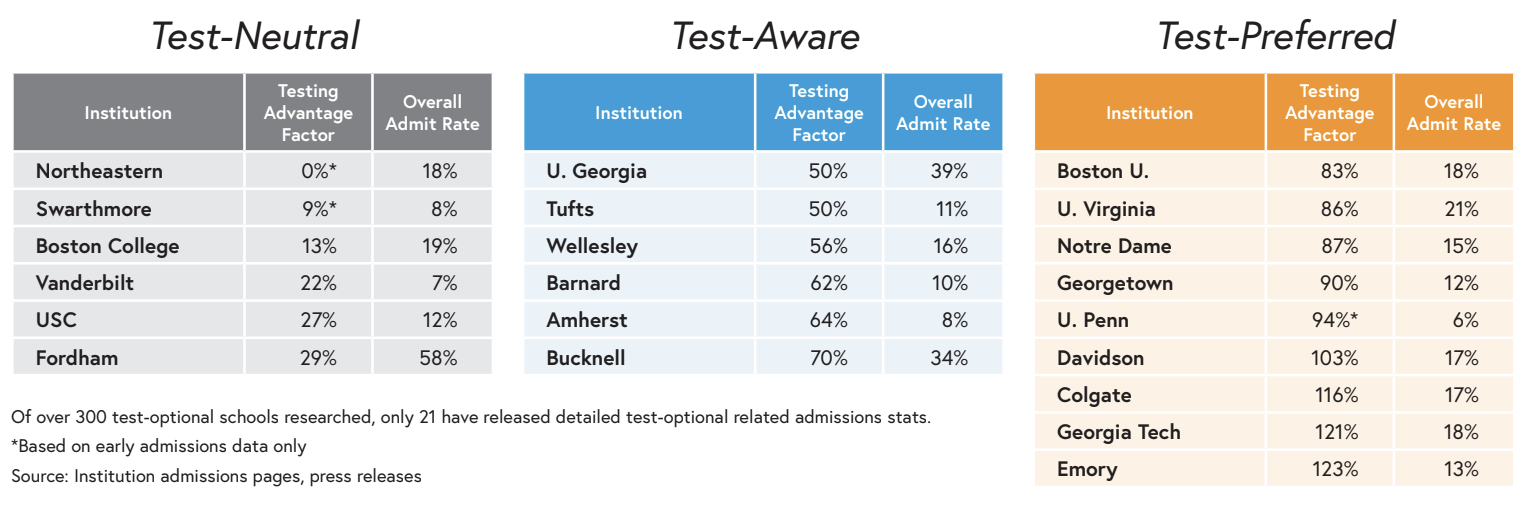Across the board, test-optional policies have led to many more applicants, stronger applicant pools (based on factors like GPA, class rank, and rigor), and greater diversity, with no significant difference in undergraduate success between submitters and non-submitters. But all test-optional policies are not equal.
What the Data Show So Far
The vast majority of colleges do not release detailed data about admission rates for test submitters vs. non-submitters, however, last year 21 colleges did. From that data, we found that applicants who submitted test scores were admitted at a higher rate than applicants without test scores, indicating a testing advantage at nearly every college on the list.
Now, we don’t know for sure if test-submitters were admitted at a higher rate simply because they submitted testing; it’s likely that applicants who submit testing are strong in other ways (GPA, course rigor, essays) that also help them stand out in the admission process. Nevertheless, the data we have show a clear correlation between test scores and a higher chance of acceptance at selective colleges.
A Framework for Understanding Test-Optional Policies: Test-Neutral, Test-Aware, Test-Preferred
Colleges have not just decided whether or not to go test-optional; they have also decided to what degree scores (or lack thereof) matter in their application review. It makes sense to divide test-optional colleges into groups based on how much of an advantage test-submitters have over non-submitters when comparing acceptance rates.
Test-neutral colleges offer little to no admission advantage to test submitters. Northeastern, for example, had no difference between acceptance rates for test submitters and non-submitters, leading to a testing advantage factor of 0%.
Test-aware colleges offer some advantage to test submitters. At Amherst, for example, the admit rate for test submitters was 64% higher than the admit rate for non-submitters.
Test-preferred colleges offer a significant advantage. Emory and Georgia Tech offered the most advantage, with admit rates for test submitters coming in 123% and 121% higher than for non-submitters.
How to Tell if a College is Test-Neutral, Test-Aware, or Test-Preferred
It is widely believed that a majority of test-optional policies are likely to continue beyond the pandemic, so it’s important to learn how to interpret what test-optional means at different colleges. While we may not have detailed admission data from most schools, there are other ways to determine whether a school you’re applying to is likely to be test-neutral, test-aware, or test-preferred:
Temporary vs. Permanent
Colleges with temporary pilot programs are more likely to be test-aware or test-preferred since they haven’t fully committed to a test-optional philosophy.
Colleges with permanent test-optional policies are more likely to be test-neutral or test-aware since they have made a long-term commitment to using a test-optional process.
Selectivity
Highly selective colleges are more likely to be test-aware or test-preferred because they need to look for every tiny distinction they can make between applicants.
Moderately selective colleges are more likely to be test-neutral or test-aware since they can be more flexible in their admission criteria.
Common Data Set
Most colleges share the importance of different application factors in their Common Data Set. You can check a school’s Common Data Set to determine whether test scores are Not Considered, Considered, Important, or Very Important. The more important test scores are, the more likely that the college is test-aware or test-preferred.

